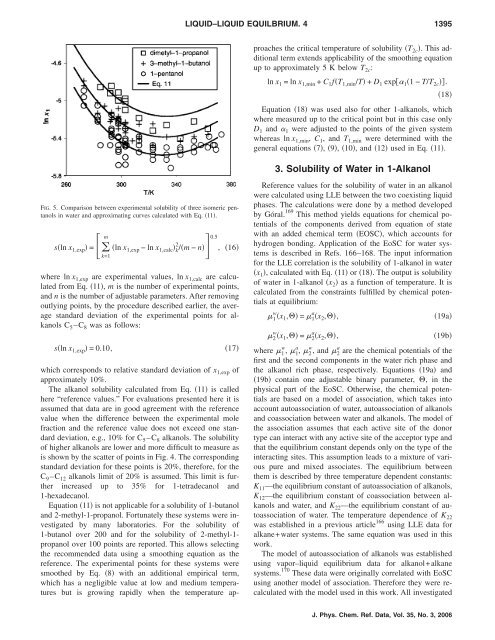Recommended Liquid–Liquid Equilibrium Data. Part 4. 1-Alkanol ...
Recommended Liquid–Liquid Equilibrium Data. Part 4. 1-Alkanol ...
Recommended Liquid–Liquid Equilibrium Data. Part 4. 1-Alkanol ...
You also want an ePaper? Increase the reach of your titles
YUMPU automatically turns print PDFs into web optimized ePapers that Google loves.
FIG. 5. Comparison between experimental solubility of three isomeric pentanols<br />
in water and approximating curves calculated with Eq. 11.<br />
m<br />
sln x 1,exp = k=1<br />
2<br />
ln x1,exp −lnx1,calck/m − n0.5<br />
, 16<br />
where ln x 1,exp are experimental values, ln x 1,calc are calculated<br />
from Eq. 11, m is the number of experimental points,<br />
and n is the number of adjustable parameters. After removing<br />
outlying points, by the procedure described earlier, the average<br />
standard deviation of the experimental points for alkanols<br />
C 5–C 8 was as follows:<br />
sln x 1,exp = 0.10, 17<br />
which corresponds to relative standard deviation of x 1,exp of<br />
approximately 10%.<br />
The alkanol solubility calculated from Eq. 11 is called<br />
here “reference values.” For evaluations presented here it is<br />
assumed that data are in good agreement with the reference<br />
value when the difference between the experimental mole<br />
fraction and the reference value does not exceed one standard<br />
deviation, e.g., 10% for C 5–C 8 alkanols. The solubility<br />
of higher alkanols are lower and more difficult to measure as<br />
is shown by the scatter of points in Fig. <strong>4.</strong> The corresponding<br />
standard deviation for these points is 20%, therefore, for the<br />
C 9–C 12 alkanols limit of 20% is assumed. This limit is further<br />
increased up to 35% for 1-tetradecanol and<br />
1-hexadecanol.<br />
Equation 11 is not applicable for a solubility of 1-butanol<br />
and 2-methyl-1-propanol. Fortunately these systems were investigated<br />
by many laboratories. For the solubility of<br />
1-butanol over 200 and for the solubility of 2-methyl-1propanol<br />
over 100 points are reported. This allows selecting<br />
the recommended data using a smoothing equation as the<br />
reference. The experimental points for these systems were<br />
smoothed by Eq. 8 with an additional empirical term,<br />
which has a negligible value at low and medium temperatures<br />
but is growing rapidly when the temperature ap-<br />
LIQUID–LIQUID EQUILBRIUM. 4 1395<br />
proaches the critical temperature of solubility T2c. This additional<br />
term extends applicability of the smoothing equation<br />
up to approximately 5 K below T2c: ln x1 =lnx1,min + C1fT 1,min/T + D1 exp11−T/T2c. 18<br />
Equation 18 was used also for other 1-alkanols, which<br />
where measured up to the critical point but in this case only<br />
D 1 and 1 were adjusted to the points of the given system<br />
whereas ln x 1,min, C 1, and T 1,min were determined with the<br />
general equations 7, 9, 10, and 12 used in Eq. 11.<br />
3. Solubility of Water in 1-<strong>Alkanol</strong><br />
Reference values for the solubility of water in an alkanol<br />
were calculated using LLE between the two coexisting liquid<br />
phases. The calculations were done by a method developed<br />
by Góral. 169 This method yields equations for chemical potentials<br />
of the components derived from equation of state<br />
with an added chemical term EOSC, which accounts for<br />
hydrogen bonding. Application of the EoSC for water systems<br />
is described in Refs. 166–168. The input information<br />
for the LLE correlation is the solubility of 1-alkanol in water<br />
x 1, calculated with Eq. 11 or 18. The output is solubility<br />
of water in 1-alkanol x 2 as a function of temperature. It is<br />
calculated from the constraints fulfilled by chemical potentials<br />
at equilibrium:<br />
1 w x1, = 1 a x2,, 19a<br />
2 w x1, = 2 a x2,, 19b<br />
where 1 w , 1 a , 2 w , and 2 a are the chemical potentials of the<br />
first and the second components in the water rich phase and<br />
the alkanol rich phase, respectively. Equations 19a and<br />
19b contain one adjustable binary parameter, , in the<br />
physical part of the EoSC. Otherwise, the chemical potentials<br />
are based on a model of association, which takes into<br />
account autoassociation of water, autoassociation of alkanols<br />
and coassociation between water and alkanols. The model of<br />
the association assumes that each active site of the donor<br />
type can interact with any active site of the acceptor type and<br />
that the equilibrium constant depends only on the type of the<br />
interacting sites. This assumption leads to a mixture of various<br />
pure and mixed associates. The equilibrium between<br />
them is described by three temperature dependent constants:<br />
K 11—the equilibrium constant of autoassociation of alkanols,<br />
K 12—the equilibrium constant of coassociation between alkanols<br />
and water, and K 22—the equilibrium constant of autoassociation<br />
of water. The temperature dependence of K 22<br />
was established in a previous article 166 using LLE data for<br />
alkane+water systems. The same equation was used in this<br />
work.<br />
The model of autoassociation of alkanols was established<br />
using vapor–liquid equilibrium data for alkanol+alkane<br />
systems. 170 These data were originally correlated with EoSC<br />
using another model of association. Therefore they were recalculated<br />
with the model used in this work. All investigated<br />
J. Phys. Chem. Ref. <strong>Data</strong>, Vol. 35, No. 3, 2006
















